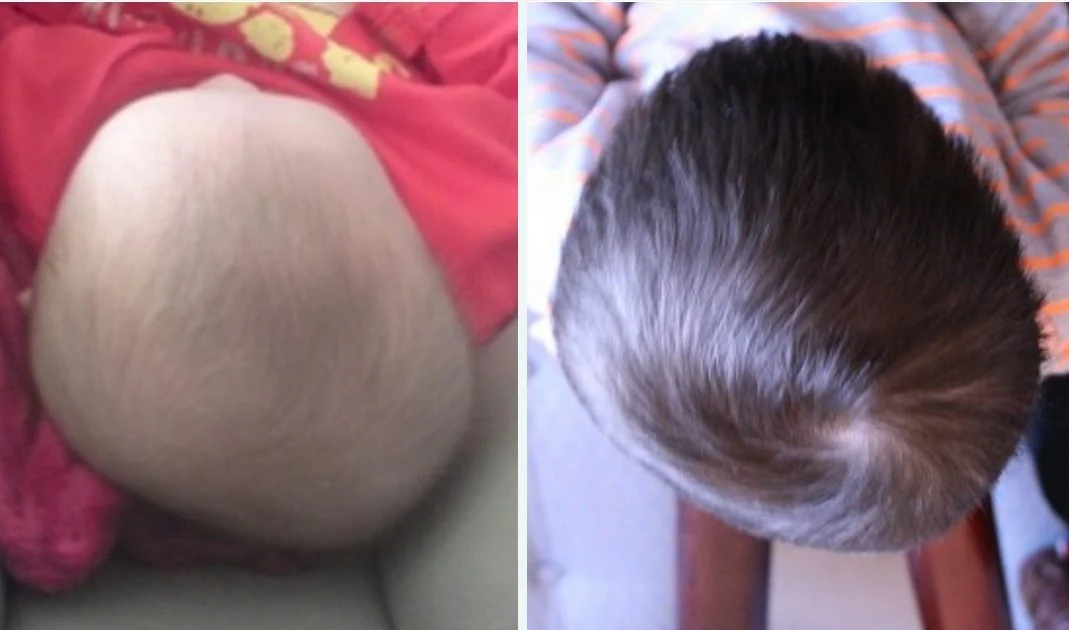
Unfortunately, plagiocephaly in adults and older children cannot be treated with a helmet, and we are left having to give this disappointing news to parents and adults with the condition.
In our ongoing pursuit to offer patients and carers a wealth of advice, information and research on plagiocephaly, we are addressing one of the biggest questions that parents ask us on a daily basis. The following question is something that many parents ask when deciding whether to go ahead with treatment for their baby or not…
What Happens If You Don't Treat Plagiocephaly?
According to official NHS advice, untreated plagiocephaly will 'usually improve' over time, advising parents that, 'your baby's head may not return to a completely perfect shape, but by the time they're one or two years old, any flattening will be barely noticeable', and, 'the appearance of your child's head should improve as they become more mobile and their hair grows'.
However, our experience and feedback from parents inform us that this isn't quite so simple. Many children, and indeed as they grow into adults, have fine or short hair, in which case a misshapen head cannot be hidden by hair growth. Additionally, this summary provided by the NHS does not recognise the practical, developmental and psychological implications of untreated plagiocephaly.
Long-Term Effects of Plagiocephaly
In recent years, more research has appeared surrounding plagiocephaly and its long-term effects. These include its physical, developmental and psychological impacts, which can become more apparent as infants age and when treatment is too late.
For parents and carers searching for information regarding untreated moderate and severe plagiocephaly, we have collated the following potential implications:
1. Developmental Delays
A study investigating the development in toddlers with and without deformational plagiocephaly (DP) found that toddlers with DP scored lower on all sections of the Bayley Scales of Infant and Toddler Development, Third Edition when compared with unaffected, demographically similar toddlers. Although this study did not establish a causal relationship, it does indicate a need for greater developmental surveillance.
2. Practical Difficulties
Practical difficulties in sport and everyday life can affect adults with plagiocephaly, as some are unable to wear many types of protective headwear for sports such as cycling and rock climbing. Most helmets and headgear are manufactured around a 'normal' head shape, so for moderate and severe flat head syndrome in adults, individuals may be unable to wear helmets.
Additionally, if someone also has significantly misaligned ears, which is sometimes the case with severe flat head syndrome, they could even face difficulties when wearing glasses on a day-to-day basis.
In addition to sporting activities, adults may also find it difficult to enter into their chosen profession due to their inability to wear standard head protection. This includes adults wanting to work in construction, the emergency services, and armed forces.
3. Psychological Impact
Flat head in adults and children may have a psychological impact later in life. A misshapen head brings a number of psychosocial concerns and emotional difficulties which a person may face throughout school and into adulthood. As a casing point, research has shown that people with symmetrical features are considered more attractive than those with asymmetrical features, but even if we ignore this research and discourage these automatic responses, there may still be peers, teachers and other adults who could react negatively to an abnormality, which can result in teasing and even bullying in some cases.
Many older children, teenagers and adults who contact us feel that they have been let down by their doctors and the lack of advice and support they were offered. Although the NHS advice says that hair growth will hide a misshapen head, longer hair doesn't improve a head shape but rather attempts to conceal the deformity - as the below photos show, hair does not necessarily hide a misshapen head.

Adults who are conscious of their head shape are unable to wear certain hairstyles if they wish to conceal plagiocephaly as an adult. This is particularly difficult for men with plagiocephaly as shorter, cropped styles will highlight a misshapen head even more. Low self-esteem and a lack of confidence in appearance can have a significant impact on their ability to socialise.
Whilst more and more research into plagiocephaly is being published online, and awareness of plagiocephaly is on the rise, healthcare professionals continue to adhere to the official NHS guidelines, which still means that many babies are being left with preventable head shape deformities.
Will Baby Flat Head Syndrome Correct Itself?
Plagiocephaly can correct itself without the need for treatment as long as the deformity is mild and it is detected at the earliest opportunity. When your baby is around 8 weeks old, you may notice that they have started to develop a flattening on the head. Providing it is introduced early enough, we will always recommend repositioning to discourage your baby from resting on the flattening whilst asleep to during playtime throughout the day.
Repositioning techniques also help to develop a baby's motor skills. Our repositioning guide offers top tips from parents and guidance from the experts on how to use repositioning to improve your baby's head shape naturally without the need for treatment.
However, as babies become older and they begin to move more independently, the success of repositioning becomes increasingly limited. Significant correction without the need for treatment will only happen in the first few months of a baby's life whilst the skull structure is still soft and the joints between the bones are more flexible and open.
Unfortunately though, moderate and severe plagiocephaly will not correct with repositioning and sometimes won't even be improved at all, instead requiring other forms of plagiocephaly treatment, such as the TiMband. However, once a baby reaches the age of 14 months, the bones in the skull have hardened and the growth rate slows dramatically. This is why we do not offer any form of plagiocephaly treatment for adults, children, and older babies.
For more information on what happens if you don't treat plagiocephaly and a detailed look into the incidences of plagiocephaly in adults, read our blog - we also include advice on effective treatment for your baby.
We always advise that you trust your parental instincts and if you are concerned about your baby's head shape, book a free pre-assessment with one of our orthotic specialists to check your baby's head shape. We offer a no-obligation assessment at your nearest clinic to help you make an informed decision about the best method of treatment for your baby.
Contact us for more information or to book an appointment, call Technology in Motion on 0113 218 8030 and speak to a specialist.


